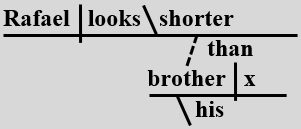Comparative Modifiers
Following is a quick lesson to teach comparative modifiers. If it works for your students, check out these related lessons: superlative modifiers, misplaced modifiers, dangling modifiers, and squinting modifiers (CCSS L.1). These modifier lessons are excerpts from Pennington Publishing’s full-year Teaching Grammar and Mechanics programs.
Comparative Modifiers Lesson
Today we are studying comparative modifiers. Remember that an adjective modifies a noun or pronoun and answers Which one? How many? or What kind? An adverb modifies a verb, an adjective, or an adverb and answers What degree? How? Where? or When? Now let’s read the grammar and usage lesson, circle or highlight the key points of the text, and study the examples.
A modifier is an adjective or adverb that limits the meaning of a word or words. Use the suffix “_er” for a one-syllable modifier to compare two things. Example: fewer than five
Use “_er” or more (less) for a two-syllable modifier to compare two things. Example: prettier, more often
Use more or less for adverb comparative modifiers ending in “__ly.” Example: less carefully.
Sentence Diagram
Comparative modifiers are placed to the right of the predicate after a backward slanted line in sentence diagrams. The object of comparison is placed under the comparative modifier and is connected with a dotted, slanted line. The unstated verb is marked as an “X” to the right of the main vertical line.Identify the comparative modifier and explain how it modifies other words in the sentence.
Want to learn more about sentence diagramming and get free lesson plans? Check out “How to Teach Sentence Diagramming.”
Mentor Text
This mentor text, written by Martin Luther King Jr. (the civil rights leader and minister), uses a comparative modifier to contrast love and evil.
Let’s read it carefully: “I believe that unarmed truth and unconditional love will have the final word in reality. That is why right, temporarily defeated, is stronger than evil triumphant.”
Identify the comparative modifier and explain how Dr. King uses it to help make his point.
Writing Application

Syntax in Reading and Writing
Now let’s apply what we’ve learned to respond to this quote and compose a sentence with a two-syllable comparative modifier and a three-syllable comparative modifier.
Remember that the above lesson is just an excerpt of the full lesson from my Teaching Grammar and Mechanics programs. Want the full lesson, formatted for display, and the accompanying student worksheet with the full lesson text, practice, fill-in-the-blank simple sentence diagram, practice (including error analysis), and formative assessment sentence dictation? You’ve got it! I want you to see the instructional quality of my full-year programs. Click below and submit your email to opt in to our Pennington Publishing newsletter, and you’ll get the lesson immediately.
*****
 Click to view the quick Grade 4 Video Preview or PDF Program Preview.
Click to view the quick Grade 4 Video Preview or PDF Program Preview.
Click to view the quick Grade 5 Video Preview or PDF Program Preview.
Click to view the quick Grade 6 Video Preview or PDF Program Preview.
Click to view the quick Grade 7 Video Preview or PDF Program Preview.
Click to view the quick Grade 8 Video Preview or PDF Program Preview.
Each Teaching Grammar, Usage, and Mechanics Grades 4, 5, 6, 7, and 8 full-year program includes lessons, independent practice, and unit tests in printable PDFs, Google slides, forms, and sheets. Students will love the secret agent theme in the Google slides with drag and drop activities, type-in-the-box practice, audio files, and problem-solving (secret codes and such). The theme is fun, but the learning tasks are rigorous.
Also available from Pennington Publishing: High school, interactive notebook, and literacy center grammar programs. Enter discount code 3716 at check-out for the lowest price on Pennington Publishing programs.

